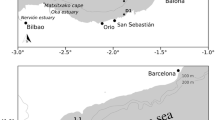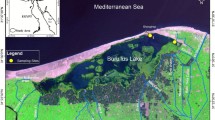Abstract
Laboratory estimates of the minimum concentration of food required for survival of marine fish larvae usually are much higher than the average concentrations of food in the sea (O’Connell and Raymond, 1970; Hunter, 1972). A common explanation for the fact that laboratory food requirements exceed natural food densities is that larvae are able to find and remain in patches of food in the sea which are considerably above the average food density estimated from plankton net catches. This explanation is supported in part by Ivlev (1961) who demonstrated with carp fry that an increase in the degree of aggregation of prey had the same effect on food consumed as an increase in the overall density of food material. A patchy distribution of larval food occurs under natural conditions. Thus, the effect of prey distribution on feeding behaviour of larval fish and the scale of “patchiness” of food items in the sea must be known to estimate the impact of food distribution on the feeding and searching behaviour of larval anchovy. This paper described some aspects of the effect of prey distribution and density on the feeding and searching behaviour of larval anchovy Engraulis mordax Girard.
Access this chapter
Tax calculation will be finalised at checkout
Purchases are for personal use only
Preview
Unable to display preview. Download preview PDF.
Similar content being viewed by others
References
Arthur, D.K., 1956. The particulate food and the food resources of the larvae of three pelagic fishes, especially the Pacific sardine, Sardinops caerulea (Girard). Thesis, Univ. Calif., San Diego, 231 p.
Beukema, J.J., 1968. Predation by the three-spined stickleback (Gasterosteus aculeatus L.): The influence of hunger and experience. Behaviour, 31 (1), 126 p.
Cody, M.L., 1971. Finch flocks in the Mohave Desert. Theor. Pop. Biol., 2 (2), 142–158.
Conway, G.R., Glass, N.R. and Wilcox, J.C., 1970. Fitting nonlinear models to biological data by Marquardt’s algorithm. Ecology, 51 (3), 503–507.
El-Sayed, S.Z., 1971. Observations on phytoplankton bloom in the Weddell Sea. Antarct. Res. Ser., 17, 301–312.
Fogg, G.E., 1962. Extracellular products. In: Physiology and biochemistry of algae, R.A. Lewin (ed.). New York — London: Academic Press, 475–489 pp.
Hellebust, J.A., 1965. Excretion of some organic compounds by marine phytoplankton. Limnol. Oceanogr., 10 (2), 192–206.
Hunter, J.R., 1972. Swimming and feeding behavior of larval anchovy Engraulis mordax. Fish. Bull., U.S., 70 (3), 821–838.
Ivlev, V.S., 1961. Experimental ecology of the feeding of fishes. Yale University Press, 302 p.
Kleerekoper, H., 1967. Some aspects of olfaction in fishes, with special reference to orientation. Am. Zool., 7 (3), 385–395.
Kleerekoper, H., Timms, A.M., Westlake, G.F., Davy, F.B., Malar, T. and Anderson, V.M., 1970. An analysis of locomotor behaviour of goldfish (Crassius auratus). Anim. Behav., 18 (2), 317–330.
Lasker, R., Feder, H.M., Theilacker, G.H. and May, R.C., 1970. Feeding, growth, and survival of Engraulis mordax larvae reared in the laboratory. Mar. Biol., 5 (4), 345–353.
Lenarz, W.H., 1972. Mesh retention of larvae of Sardinops caerulea and Engraulis mordax by plankton nets. Fish. Bull., U.S., 70 (3), 839–848.
O’Connell, C.P. and Raymond, L.P., 1970. The effect of food density on survival and growth of early post-yolk-sac larvae of the northern anchovy (Engraulis mordax Girard) in the laboratory. J. Exp. Mar. Biol. Ecol., 5 (2), 187–197.
Siegel, S., 1956. Nonparametric statistics for the behavioral sciences. New York: McGraw-Hill, 312 p.
Sweeney, B.M., 1959. Endogenous diurnal rhythms in marine dinoflagellates. Preprints Intern. Oceanogr. Congr., Aug.-Sept. 1959 (M. Sears, ed.), 204–207 p. Washington, D.C.: A. Assoc. Advancement Sci.
Thomas, W.H., Dodson, N. and Linden, C.A., 1973. Optimum light and temperature requirements for Gyrnnodinium splendens; a larval fish food organism. Fish. Bull., U.S., 71, 599–601.
Wyatt, T., 1972. Some effects of food density on the growth and behaviour of plaice larvae. Mar. Biol., 14 (3), 210–216.
Author information
Authors and Affiliations
Editor information
Editors and Affiliations
Rights and permissions
Copyright information
© 1974 Springer-Verlag Berlin · Heidelberg
About this paper
Cite this paper
Hunter, J.R., Thomas, G.L. (1974). Effect of Prey Distribution and Density on the Searching and Feeding Behaviour of Larval Anchovy Engraulis mordax Girard. In: Blaxter, J.H.S. (eds) The Early Life History of Fish. Springer, Berlin, Heidelberg. https://doi.org/10.1007/978-3-642-65852-5_45
Download citation
DOI: https://doi.org/10.1007/978-3-642-65852-5_45
Publisher Name: Springer, Berlin, Heidelberg
Print ISBN: 978-3-642-65854-9
Online ISBN: 978-3-642-65852-5
eBook Packages: Springer Book Archive




